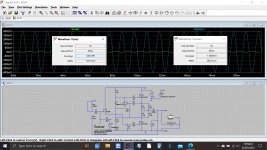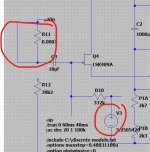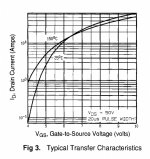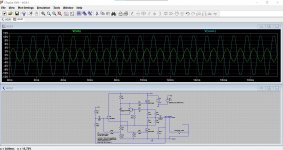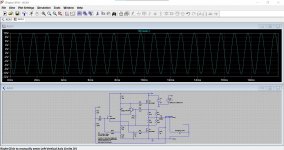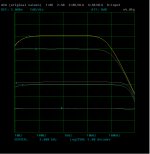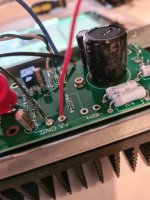Does anyone know what the input voltage is to get to max power on the ACA... I am setting up my MiniDSP DDRC88A, and I need the info for internal output gain.
Sensitivity of the ACA is listed as 4W @ 1.72V, output as 4.5W @ 1%
2.5V (RMS) input = 7.77V (RMS) output, into an 8 ohm load = 7.59 watts.
With 24V power supply.
With 24V power supply.
Last edited:
Fun fact! If the open loop gain of the ACA v1.8 were infinity (like a textbook ideal opamp) then the closed loop voltage gain of the amplifier + feedback network would equal (-1)*(R12/R11) = -4.0. In this phony baloney scenario, the input sensitivity would be sqrt(4W * 8R) / (4) = 1.414V.
HOWEVER, the open loop gain of the ACA is certainly not infinity, and that means the closed loop voltage gain of the amplifier + feedback network is certainly not -4.0 .
From the data in #9801 above, we can calculate that the closed loop voltage gain is about -3.3 . {why? because an input of 1.72V, times a gain of 3.3x, gives an output of 5.676 volts. And 5.676 volts delivers 4.0 watts into an 8 ohm load}
AHA so now we have enough information to calculate the open loop gain "OLG" of the v1.8 Amp Camp Amp, when driving an 8 ohm load. We know it isn't infinity (no Nelson Pass amplifier has an open loop gain of infinity!), so what is the actual number?
Miserable EE students who suffered through their 2nd year curriculum of unrelenting nonstop torture, will tell you that an inverting amplifier like the ACA, has a closed loop gain which is equal to
ClosedLoopGain = (-1) * 1 / [(1 / OLG) + (R11/R12)*(1 + (1/OLG))]
Studying this expression: we know the closed loop gain, we know the resistor ratio (R11/R12) so the only unknown is OLG, the open loop gain. "Merely" (!) rearrange this expression to solve for OLG.
And presto, the answer pops out: OLG = Open Loop Gain of the ACA, when driving an 8 ohm load, equals 23.1 times. Not infinity. To be a pragmatist, the open loop gain is "about twenty or so" and is definitely closer to 20 than it is to 200.
HOWEVER, the open loop gain of the ACA is certainly not infinity, and that means the closed loop voltage gain of the amplifier + feedback network is certainly not -4.0 .
From the data in #9801 above, we can calculate that the closed loop voltage gain is about -3.3 . {why? because an input of 1.72V, times a gain of 3.3x, gives an output of 5.676 volts. And 5.676 volts delivers 4.0 watts into an 8 ohm load}
AHA so now we have enough information to calculate the open loop gain "OLG" of the v1.8 Amp Camp Amp, when driving an 8 ohm load. We know it isn't infinity (no Nelson Pass amplifier has an open loop gain of infinity!), so what is the actual number?
Miserable EE students who suffered through their 2nd year curriculum of unrelenting nonstop torture, will tell you that an inverting amplifier like the ACA, has a closed loop gain which is equal to
ClosedLoopGain = (-1) * 1 / [(1 / OLG) + (R11/R12)*(1 + (1/OLG))]
Studying this expression: we know the closed loop gain, we know the resistor ratio (R11/R12) so the only unknown is OLG, the open loop gain. "Merely" (!) rearrange this expression to solve for OLG.
And presto, the answer pops out: OLG = Open Loop Gain of the ACA, when driving an 8 ohm load, equals 23.1 times. Not infinity. To be a pragmatist, the open loop gain is "about twenty or so" and is definitely closer to 20 than it is to 200.
It's a source follower stage (gain approx 0.98) then a common source amplifier stage (gain equals (gm * Rspeaker)). Interpolating the datasheet curve for the common source MOSFET, gm is around 2.5 to 3.3 Siemens, giving a stage gain of 20x to 26x with an 8 ohm speaker.
_
_
Attachments
@Mooly
Would you put 2.5V input in your model and see how close it comes to my measurements above?
Would you put 2.5V input in your model and see how close it comes to my measurements above?
Look at the X-Y oscilloscope photo I posted in reply 274 of this thread. The slope of the line is the open loop gain of the ACA (first version with 19V rail).
See how the line curves ? That means the gain is not linear. Feedback corrects this to some extent, but you'll get a different number when you change the amplitude of the signal used to try to measure OLG.
See how there is a loop in the trace. I think this is thermal distortion where Q1 is at a slightly different temperature on the way up versus on the way down. Not much discussion of that topic here.
See how the line curves ? That means the gain is not linear. Feedback corrects this to some extent, but you'll get a different number when you change the amplitude of the signal used to try to measure OLG.
See how there is a loop in the trace. I think this is thermal distortion where Q1 is at a slightly different temperature on the way up versus on the way down. Not much discussion of that topic here.
logical to expect from circuit so simple, and you don't need scope to realize that
even if pentodish in nature, gain device is relatively crude one, and there is simply not enough OLG to count on NFB to correct that
though, as we know what was intention with ACA, all boxes ticked
even if pentodish in nature, gain device is relatively crude one, and there is simply not enough OLG to count on NFB to correct that
though, as we know what was intention with ACA, all boxes ticked
Thank you... I will switch to 8v out on the DRRC88A.2.5V (RMS) input = 7.77V (RMS) output, into an 8 ohm load = 7.59 watts.
With 24V power supply.
@Mooly
Would you put 2.5V input in your model and see how close it comes to my measurements above?
2.5vrms just brings the sim to clipping (24v supply). 2.2vrms is just about OK and gives 7.25vrms output.
Attachments
5 watts is 6.32vac into 8 ohms, gain is 47k/10k or 4.7, so that input voltage is 6.32/4.7 or 1.44 volts....
Death and taxes
Not in the UK, but in France, so EU: I just received two ACA parts-only kits with 2 Meanwell PS from the DIYaudio store.
Total cost:
$356.00 goods (diyaudio store)
$68.95 shipping (diyaudio store, USPS international)
Eur 62.00 French VAT at 20%
Eur 15.00 Handling charge (frais de dedouanement) by French post office.
So in total (including shipping) about 40% overhead.
Ordered Feb. 17, missed delivery yesterday, picked up at the post office today, Mar. 09. Still waiting for the enclosures from Italy (ordered later). At least there should not be any extra charges there.
The cost of the electronic parts kit is very competitive if you add up the cost of all the parts ordered as a person building one or two would. Perhaps the same or cheaper.We find that we need to get the parts from various companies, so there's the multiple shipping charges too.
EDIT: Oh snap! I didn't see you were in the UK. Would be interesting to hear how much people are charged for duties. I'll bet it ranges from zero to 2x the cost of the kit!
Not in the UK, but in France, so EU: I just received two ACA parts-only kits with 2 Meanwell PS from the DIYaudio store.
Total cost:
$356.00 goods (diyaudio store)
$68.95 shipping (diyaudio store, USPS international)
Eur 62.00 French VAT at 20%
Eur 15.00 Handling charge (frais de dedouanement) by French post office.
So in total (including shipping) about 40% overhead.
Ordered Feb. 17, missed delivery yesterday, picked up at the post office today, Mar. 09. Still waiting for the enclosures from Italy (ordered later). At least there should not be any extra charges there.
Not in the UK, but in France, so EU: I just received two ACA parts-only kits with 2 Meanwell PS from the DIYaudio store.
Total cost:
$356.00 goods (diyaudio store)
$68.95 shipping (diyaudio store, USPS international)
Eur 62.00 French VAT at 20%
Eur 15.00 Handling charge (frais de dedouanement) by French post office.
So in total (including shipping) about 40% overhead.
Ordered Feb. 17, missed delivery yesterday, picked up at the post office today, Mar. 09. Still waiting for the enclosures from Italy (ordered later). At least there should not be any extra charges there.
Shipping was about the same to the US...no VAT or extra handling so other than the government money grab its reasonable imo.
Very interesting. I wonder if anyone has actually measured it in practice. The sim gives an OLG of around 40 numerically (or 32db) so you and the sim seem certainly seem to be in the right ballpark.
With 8R load the measured OLG is 30.5dB (very close to the sim). With 4R load the OLG is 24.5dB.
Attachments
no need to belabor this, remember simulations and calculations are based on sine waves, but in real life, music is our input signal and also to our speakers....
so unless you can can convert music signals to equivalent sine, then all bets are off....
so unless you can can convert music signals to equivalent sine, then all bets are off....
Thanks! I spent the time to dial in all 3 bridged amps to 12.0. That took quite a while trying to nail it at 12.0, but I did it. I kmow the instructions say a couple of tenths are ok, but I figured since they are bridged mono, I should get a s close as I can.
- Home
- Amplifiers
- Pass Labs
- Amp Camp Amp - ACA
